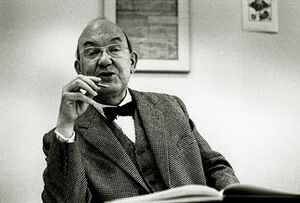Jan Tschichold (nonfiction): Difference between revisions
(Created page with "thumb|Jan Tschichold (1963).'''Jan Tschichold''' (2 April 1902 Leipzig, Germany – 11 August 1974 Locarno, Switzerland...") |
No edit summary |
||
| Line 1: | Line 1: | ||
[[File:Jan_Tschichold_(1963)_by_Erling_Mandelmann.jpg|thumb|Jan Tschichold (1963).]]'''Jan Tschichold''' (2 April 1902 Leipzig, Germany – 11 August 1974 Locarno, Switzerland) was a typographer, book designer, teacher, and writer. | [[File:Jan_Tschichold_(1963)_by_Erling_Mandelmann.jpg|thumb|Jan Tschichold (1963).]]'''Jan Tschichold''' (2 April 1902 Leipzig, Germany – 11 August 1974 Locarno, Switzerland) was a typographer, book designer, teacher, and writer. | ||
Tschichold had converted to Modernist design principles in 1923 after visiting the first Weimar Bauhaus exhibition. He became a leading advocate of Modernist design: first with an influential 1925 magazine supplement; then a 1927 personal exhibition; then with his most noted work ''Die neue Typographie''. This book was a manifesto of modern design, in which he condemned all typefaces but sans-serif (called Grotesk in Germany). He also favoured non-centered design (e.g., on title pages), and codified many other Modernist design rules. He advocated the use of standardised paper sizes for all printed matter, and made some of the first clear explanations of the effective use of different sizes and weights of type in order to quickly and easily convey information. This book was followed with a series of practical manuals on the principles of Modernist typography which had a wide influence among ordinary workers and printers in Germany. | |||
Tschichold slowly abandoned his rigid beliefs from around 1932 onwards (e.g. his Saskia typeface of 1932, and his acceptance of classical Roman typefaces for body-type) as he moved back towards Classicism in print design. He later condemned ''Die neue Typographie'' as too extreme. He also went so far as to condemn Modernist design in general as being authoritarian and inherently fascistic. | |||
His abandonment of Modernist principles meant that, even though he was living in Switzerland after the war, he was not at the center of the post-war Swiss International Typographic Style. | |||
Between 1947–1949 Tschichold lived in England where he oversaw the redesign of 500 paperbacks published by Penguin Books, leaving them with a standardized set of typographic rules, the Penguin Composition Rules. | |||
== In the News == | == In the News == | ||
Revision as of 09:24, 19 February 2017
Jan Tschichold (2 April 1902 Leipzig, Germany – 11 August 1974 Locarno, Switzerland) was a typographer, book designer, teacher, and writer.
Tschichold had converted to Modernist design principles in 1923 after visiting the first Weimar Bauhaus exhibition. He became a leading advocate of Modernist design: first with an influential 1925 magazine supplement; then a 1927 personal exhibition; then with his most noted work Die neue Typographie. This book was a manifesto of modern design, in which he condemned all typefaces but sans-serif (called Grotesk in Germany). He also favoured non-centered design (e.g., on title pages), and codified many other Modernist design rules. He advocated the use of standardised paper sizes for all printed matter, and made some of the first clear explanations of the effective use of different sizes and weights of type in order to quickly and easily convey information. This book was followed with a series of practical manuals on the principles of Modernist typography which had a wide influence among ordinary workers and printers in Germany.
Tschichold slowly abandoned his rigid beliefs from around 1932 onwards (e.g. his Saskia typeface of 1932, and his acceptance of classical Roman typefaces for body-type) as he moved back towards Classicism in print design. He later condemned Die neue Typographie as too extreme. He also went so far as to condemn Modernist design in general as being authoritarian and inherently fascistic.
His abandonment of Modernist principles meant that, even though he was living in Switzerland after the war, he was not at the center of the post-war Swiss International Typographic Style.
Between 1947–1949 Tschichold lived in England where he oversaw the redesign of 500 paperbacks published by Penguin Books, leaving them with a standardized set of typographic rules, the Penguin Composition Rules.
In the News
Fiction cross-reference
Nonfiction cross-reference
External links:
- Jan Tschichold @ Wikipedia
